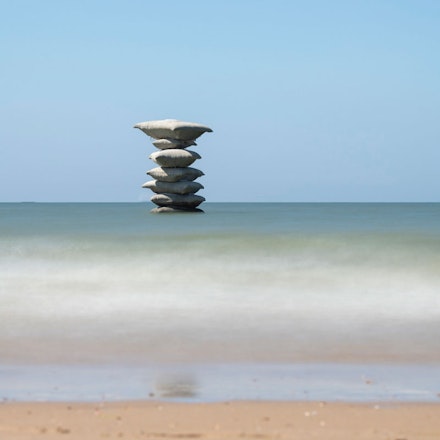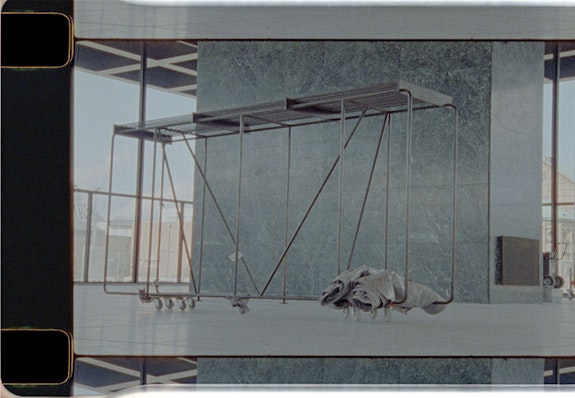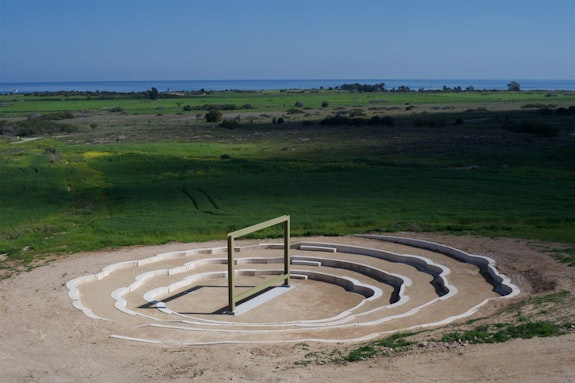Critics Page
In a Perpetual Now

July 10, 2021
“Time” is a recurring protagonist and tool in my work to examine or try to understand the world around us. In approaching the understanding of Time, one needs to constantly shift perspective in all directions—not just following a linear movement.
To move between Times, I often use cinema in order to stage an intervention in a real space, confronting the division between public and private, fantasy and reality. This allows me to navigate the past and merge it with present and future desires or preoccupations.
When I was invited by the curator Heide Ballet to propose a permanent sculpture for the 2021 Beaufort Triennial (Belgium) at the sea, I was excited to let the Ocean become the tool for Time and vice versa. Pillage of the Sea (2021) is a yardstick that gets activated and becomes visible through the Ocean’s tides. It is sometimes more visible than other times.
It will be at some point invisible during certain times—during the high tide of the day. This will happen when all the fabric casted bags that make up the sculpture, each of which represents a city, are submerged by the water. World cities like Jakarta, Chennai, Bangkok, Rio de Janeiro, and Miami are visualized each by a sandbag whose size corresponds with the current population size of that city.

The bags are piled on top of each other like a balancing, fragile act. The position of each bag signifies the altitude of the place in relation to the sea level, which is constantly rising, and the city’s names on the bags are fading and need to be remembered—re-signed from time to time.
The sculptural form is inspired by the piled-up stones in landscapes by hikers and wish-senders to the future. I encountered many of them when working on my film Aggregate States of Matters (2019) in Peru.
Pillage of the Sea is a sort of measuring stick for the transformation we are living through. A visual translation reminding us of the rising ocean levels. It is not meant as a threat, putting our hopes down, but rather it could activate a different approach in our daily life, introduce more care and energy for repair. Sometimes it takes a visual reminder to introduce such an awareness.
But the piece is not only meant to function as a reminder; it is sending a wish—an offering out to nature.

I learned in Peru from a Quechua community, during my film shoot and research for Aggregate States of Matters, how important that is. The communities that are affected by glacial melting and its geological time become present today. In a cautious, yet scrutinized, exploration, the film illustrates blurring and melding boundaries between human and non-human actors. While the Indigenous population profits from the benefits and wealth of farming, which rapidly increase due to changing environmental conditions, they concurrently face fast-moving challenges in their spiritual and cultural lives. Starting from an extensive dialogue with the local people, I tried to draw a critical picture of a world where progress and growth have stopped making sense, without reducing the complexity of the current situation in our era.
The Aboriginal approach of Time is to not perceive time as an exclusively linear category, but to often place events in a circular pattern of time. The circular pattern is very present in my work by way of recurring, layered themes, looping devices for endless material carrying narratives of inscriptions and circling camera movements.
In my ongoing conversations with scientists at CERN (European Council for Nuclear Research), with whom I am starting a project about the unknown field of dark matter, I have learned that recent discoveries pointed out that this mysterious substance exists not just in our galaxy but also between you and me—as we speak.
Dark matter is distributed commonly throughout the universe, not only in space, but also in time—in other words, its effect is not weakened as the universe expands.
This leads me to think that it is possible that time might also sometimes fall into these vacuum spaces. We think we have control over it, or at least we can measure it with our calendar systems, etc., but what if it does disappear, abruptly, while we stand here? Time might follow other unknown principles.
With Inside the Outset – Evoking a Space of Passage (2021)—a project that I finalized this summer, after seven years of preparation and negotiation with the United Nations—I created a circular outdoor cinema in the UN buffer zone of Cyprus, in the deserted so-called Green Line which was introduced in 1974 and still divides the north and south of the island and its communities. The circular shape of the cinema’s rammed earth benches, which are integrated in the natural environment, reminds one of an amphitheater, with a permeable metal screen in the middle of it that allows the films to be seen from both sides—all sides. This temporary architectural installation will disappear over time and resume with nature—hopefully after the cinema has fulfilled its purposes of its time and served all the communities on the island.

In my upcoming exhibition In a Perpetual Now for the reopening of the Neue Nationalgalerie in Berlin, I introduced a sculpture of an unrealized building by Mies van der Rohe like a blueprint into the space, holding several of my works made between 2009 and now.
Architecture, in this context, is not merely three-dimensional space, but a temporal process that constantly updates itself; it constructs itself in the movement and perception of subjects, and thus it itself remains mobile. Moreover, here architecture is meant to create spaces for unforeseen resonances between the designing subject and social communities (bodies in motion) and their living environment.

